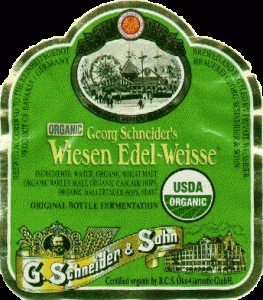Spring is in the air, dearest Brew Man Group readers. The trees have blossomed. Waterloo’s grass has returned to its perfect hue of crap-stained green. Short-shorts have started showing up in some of the best and worst situations imaginable. Glee has inexplicably taken over popular culture (sorry, but we fail t0 see the artistic merit or entertainment value in a group of stereotyped adolescents kickin’ it to All the Single Ladies). But most importantly, Dan and Neil’s glasses are filled with a liquid that has less than 8.4% alcohol. Have we turned into pussies? Don’t be silly. It’s because in the spring and summer months, it is one’s duty to sit and drink beer on a deck (or dock, if available) for hours on end, withstand scorching heat, look really cool in sunglasses, kick some ass at Frisbee, and somehow maintain sufficient sobriety to barbecue the best damn burger you’ve ever tasted. An 11% imperial stout is not exactly conducive to such activities. So at this time of year, we beer lovers reach for something more refreshing and slightly less intoxicating. There are several options available, but as far a we’re concerned, few things are better than a cloudy, cool hefeweizen on a hot summer day.
Neil – Ah yeah, it’s that time of year again, the first issue of this term; probably filled with the most soulless jeering you’ve heard since grade school (or maybe grad school in Dan’s case).
Anyway, let’s get the point; weizen beers. Essentially translating to wheat beer, from both their pale and cloudy colour and connection to a large portion of wheat in the grist (that’s the term for the grains used in brewing), weizen beers have a long history beginning in Munich, Bavaria. During the 15th century, the noble family of Degenberger produced and regulated all brews using weizen. These cheeky bastards kept all the rights to themselves; not allowing other upstarts any leaway. Fast-forward a little later, and the Degenberger monopoly has ended, only to be replaced by a long series of duke ownerships. However during this period (approximately 1600), the first weizen-only brewery was constructed in Munich; a large step forward considering that traditional barley was always a competitor. In fact, the competition was so intense as to cause a major decline in wheat beer popularity in the late 18th century. For these reasons, the would-be ducal monopoly on weizen beers was officially abolished in 1872, opening the opportunity for Georg Schneider to open the first publicly owned weizen brewery.
Dan – The hefeweizen we’re contemplating today is the Organic Wiesen Edel-Weisse, a seasonal addition at the LCBO for this year’s warmer months. This one comes to us from the German brewery G. Schneider & Sohn to which Neil previously alluded. The brewery has remained in the same family since it began in 1872. It seems Georg Schneider VI currently has control, but G.S.VII is now 15 years old and I’m sure is being groomed for the job (possibly in his high-school beer brewing course… yes, Germany actually has that). The brewery began in Munich, though they later picked up ducal brew-houses in Kelheim and Straubing. The Munich brewery was destroyed in WWII bombings (if only we knew what we were doing…), moving all production to Kelheim in 1944, where it remains today.
Schneider’s entire line-up consists of wheat beers, currently ranging from a non-alcoholic hefeweizen (“hefe” denotes an unfiltered product with yeast), to the 12% Aventinus Weizen-Eisbock which was covered in a previous Brew Man Group issue. The Edel-Weisse is a fairly typical hefeweizen, but has been brewed with cascade hops (commonly found in American pale ales), giving it a unique component. Recent projects for G. Schneider & Sohn include a collaboration with renowned Brooklyn Brewery in New York City that yielded Hopfen-Weisse, a very hoppy 8.3% hefeweizen that packs in a ton of flavour (and will be available at the LCBO later this summer). Neil said he’s already pitching a tent for that one… not sure if it’s outside the LCBO warehouse or in his cutoff jean shorts.
Neil – Most hefeweizens are produced using a 1:2 or 2:3 blend of wheat to awesome (OK, two row barley), a classic triple decoction method (a process of stepped heating during mashing), and a German yeast with low flocculation (WTF is that, right?). The resulting brew typically yields a result similar, but not identical to the Organic Wiesen Edel-Weisse. To put it short and simple, my first thoughts were, “Aw, now this is one dynamic weizen!”. The orange hue is atypical for sure, however the traditional characteristics show through on the nose; the aromas of yeast, clove and banana. These are carried though on first taste, however perhaps the mouth-feel is a tad bit more heavy than most other lighter weizen beers. By no means is this a deterrent, in fact, I think this is really how a hefeweizen should have tasted in the first place. F’ing delightful, and don’t you dare think otherwise (I might send you a mean email, or something like that). For those of you who are tired of those generic, mass-marketed, bland summer beers (you know, the ones advertised by the Big Three), why not have a little German to accompany you on that dockside Muskoka chair? Of course, a little German Fraulein would be ideal and very plausible for most of us, but Dan will most likely have to suffer (again) in solitude with several bottles of weizen beer. [4/5]
Dan: Thanks to Neil for bringing flocculation levels to my concern, that was definitely the missing link in my understanding of beer and life in general. Whatever. Beer time. This one pours into my hefeweizen glass (it’s tall and hourglass shaped, which yes, does mean I find it sexually attractive) as a cloudy, bubbly, beige-orange brew topped with a thick white head. Cloves are the first thing that jump out at your nostrils, but are quickly backed up with a hint of lemon/lime citrus. The first sip reveals some bubblegum flavours that my nose wasn’t able to pick up, coupled with the aforementioned clove, a touch of mint, and finished off with a pleasant citrus hop bitterness. This is all complimented by the perfect amount of carbonation and a smooth, full texture. Seriously, great beer. Many hefeweizens are a little unbalanced towards the sweet side, but the addition of cascade hops in this one addresses that issue perfectly, resulting in one of the most refreshing hefe’s I’ve had to date. If my dock had a mini-fridge it would be at least half full of this. I almost wish this thing weren’t 6.2% alcohol; I might have to stop after five bottles. Ok, six. [4.5/5]
Recommended for consumption if you like: Schneider-Weisse, Hacker-Pschorr, Paulaner, Weihenstephaner, Muskoka Hefeweiss
Props to hops // Dan and Neil





chlorella
The similarity in structure between barley grass and haemoglobin, as well as the high level of the natural detoxifier chlorophyll in barley grass, help to keep the blood moving freely through the body's system of blood vessels, helping to reduce clotting in the blood.